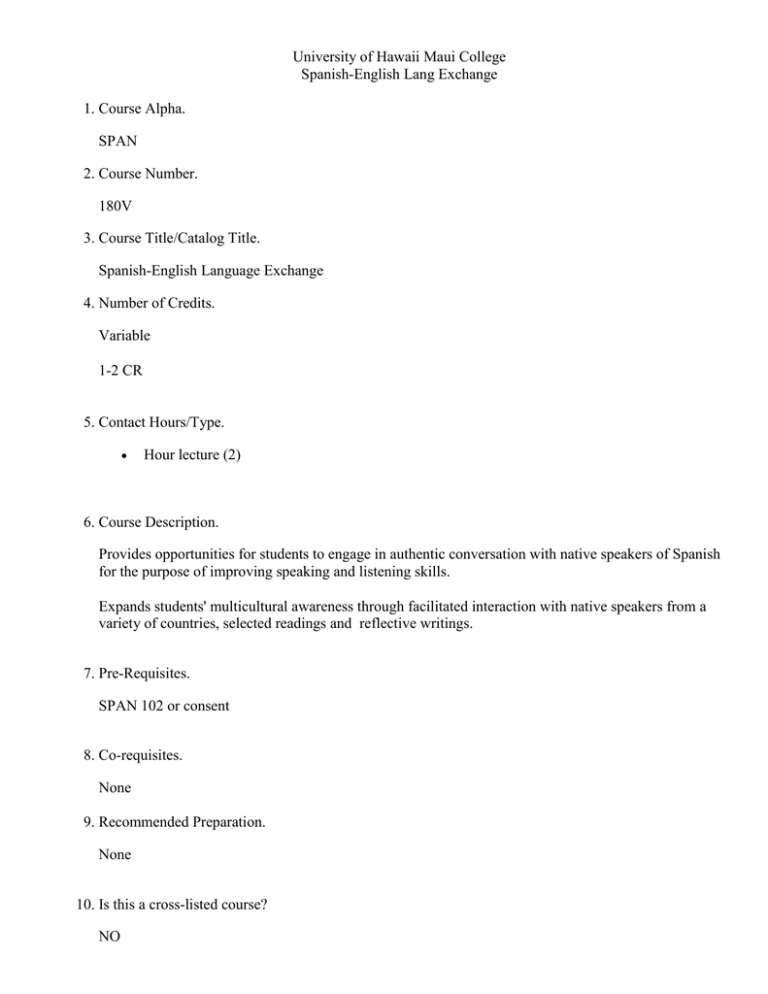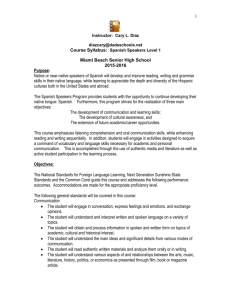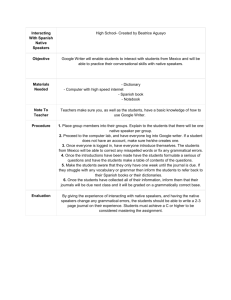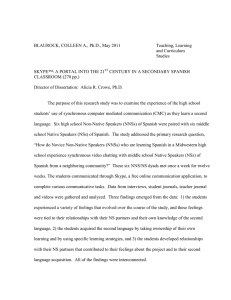
University of Hawaii Maui College
Spanish-English Lang Exchange
1. Course Alpha.
SPAN
2. Course Number.
180V
3. Course Title/Catalog Title.
Spanish-English Language Exchange
4. Number of Credits.
Variable
1-2 CR
5. Contact Hours/Type.
Hour lecture (2)
6. Course Description.
Provides opportunities for students to engage in authentic conversation with native speakers of Spanish
for the purpose of improving speaking and listening skills.
Expands students' multicultural awareness through facilitated interaction with native speakers from a
variety of countries, selected readings and reflective writings.
7. Pre-Requisites.
SPAN 102 or consent
8. Co-requisites.
None
9. Recommended Preparation.
None
10. Is this a cross-listed course?
NO
11. Reason for Proposal. Why is this course being proposed or modified? This question requires specific
information as part of the explanation.
There is a need for many students of Spanish to practice the language with a wide range of native
speakers.
Because of the recent and dramatic increase in the Hispanic population on Maui, there is an increased
need for professionals who are conversationally proficient in Spanish. This course allows students to
address their individual needs for learning Spanish while helping a native Spanish speaker improve
his/her English skills.
12. Effective Semester and Year. For new or modified courses, the effective year is one year from the
semester proposed. For example, if proposed in Spring 2012, the effective semester is Spring 2013.
Spring 2013
13. Grading Method. What grading methods may be used for this course?
Standard (Letter,Cr/NCr,Audit) (0)
14. Is this course repeatable for credit? How often can this course be counted toward a degree or
certificate?
YES
Two semesters
15. Course Student Learning Outcomes (SLOs). DO NOT ENTER TEXT IN THE TEXT BOX BELOW.
Click on the yellow button "COURSE LEARNING OUTCOMES" and enter in that screen.
Upon completion of this course students will be able to:
Comprehend native speakers of Spanish with increased ease and success;
speak Spanish with increased ease and fluency;
interact in culturally appropriate ways with native speakers of Spanish;
Course SLO/Competency
Comprehend native speakers of
Spanish with increased ease and
success;
speak Spanish with increased
ease and fluency;
interact in culturally appropriate
ways with native speakers of
Spanish;
Recognize Recognize Expand
Expand
Broaden
and apply and apply understanding vocabulary intercultural
previously- previously- of
through
understanding
studied
studied
grammatical immersion through
grammatical vocabulary structures
in authentic authentic
structures and
through
language interaction
idiomatic immersion in
with native
expressions authentic
speakers of
language
Spanish
broaden vocabulary, grammar
and knowledge of the Spanishspeaking world
Course SLO/PSLO
Students will
attain a
broad
knowledge
of the
diversity of
human
conditions
and cultures
of local and
global
communities.
Comprehend native speakers of Spanish with increased ease and success;
speak Spanish with increased ease and fluency;
interact in culturally appropriate ways with native speakers of Spanish;
broaden vocabulary, grammar and knowledge of the Spanish-speaking world
16. Course Competencies. DO NOT ENTER TEXT IN THE TEXT BOX BELOW. Click on the yellow
button "COURSE COMPETENCIES/ISSUES/SKILLS" and enter text in that screen. Course
competencies are smaller, simpler tasks that connect to and facilitate the SLOs.
Recognize and apply previously-studied grammatical structures
Recognize and apply previously-studied vocabulary and idiomatic expressions
Expand understanding of grammatical structures through immersion in authentic language
Expand vocabulary through immersion in authentic language
Broaden intercultural understanding through authentic interaction with native speakers of Spanish
Broaden understanding of the language learning process by helping native speakers of Spanish to
improve their English language fluency.
Competency
Recognize and apply previously-studied grammatical structures
Recognize and apply previously-studied vocabulary and idiomatic expressions
Expand understanding of grammatical structures through immersion in authentic language
Expand vocabulary through immersion in authentic language
Broaden intercultural understanding through authentic interaction with native speakers of Spanish
17. Recommended Course Content and Timeline. The course content facilitates the course competencies.
Course content may be organized by weeks, units, topics or the like.
Week 1-2. Introduction to the Language Exchange model. Meet participants. Introduction to strategies
for successful teaching of English, and for maximizing value of Spanish immersion.
Week 1-13
Participation in Language Exchange, with facilitation by instructor.
Week 13-14
Preparation for Intercultural Festival
Week 15
Participate in Intercultural Festival
Christmas in Fall, 5 de Mayo in Spring
Content
Week 1-2. Introduction to the Language Exchange model. Meet participants. Introduction to
strategies for successful teaching of English, and for maximizing value of Spanish immersion.
Week 1-13 Participation in Language Exchange with weekly graded assignments, including
vocabulary quizzes, reflective journals, reading and comprehension questions, internet
investigations, and group presentations.
Week 13-14 Preparation for Intercultural Festival
Week 15 Participate in Intercultural Festival Christmas in Fall, 5 de Mayo in Spring
18.
Includes, but is not limited to: group discussions, group projects, group presentations, group
exercises, group/team work in- and out-side of the classroom; appropriate rubrics. (0)
Includes, but is not limited to: assignments done outside of class in any discipline, such as math
problems, reading and questions, chapter questions, critical thinking questions, class
preparation; appropriate rubrics. (0)
Includes, but is not limited to: attendance, participation, readings, art projects, media reviews,
reactions to speakers, critical thinking exercises, or reflective exercises; appropriate rubrics. (0)
Includes, but is not limited to: reading logs, reflective journals, mentoring logs, tutoring logs,
personal growth journals, professional logs, service learning logs; appropriate rubrics. (0)
Method of
Evaluation
Course SLOs
Comprehend
native speakers
of Spanish with
increased ease
and success;
speak Spanish
with increased
ease and fluency;
interact in
culturally
appropriate ways
with native
speakers of
Includes, but is not
limited to:
assignments done
outside of class in
any discipline, such
as math problems,
reading and
questions, chapter
questions, critical
thinking questions,
class preparation;
appropriate rubrics.
Includes, but is not
limited to:
attendance,
participation,
readings, art
projects, media
reviews, reactions
to speakers, critical
thinking exercises,
or reflective
exercises;
appropriate rubrics.
Includes, but is not Includes, but is not
limited to: group
limited to: reading
discussions, group logs, reflective
projects, group
journals,
presentations, group mentoring logs,
exercises,
tutoring logs,
group/team work personal growth
in- and out-side of journals,
the classroom;
professional logs,
appropriate rubrics. service learning
logs; appropriate
rubrics.
Spanish;
broaden
vocabulary,
grammar and
knowledge of the
Spanishspeaking world
Course Competencies
Recognize and
apply previouslystudied
grammatical
structures
Recognize and
apply previouslystudied
vocabulary and
idiomatic
expressions
Expand
understanding of
grammatical
structures
through
immersion in
authentic
language
Expand
vocabulary
through
immersion in
authentic
language
Broaden
intercultural
understanding
through authentic
interaction with
native speakers
of Spanish
Method of Evaluation
Includes, but is not limited to: assignments done outside of class in any discipline, such as math
problems, reading and questions, chapter questions, critical thinking questions, class preparation;
appropriate rubrics.
Includes, but is not limited to: attendance, participation, readings, art projects, media reviews,
reactions to speakers, critical thinking exercises, or reflective exercises; appropriate rubrics.
Includes, but is not limited to: group discussions, group projects, group presentations, group
exercises, group/team work in- and out-side of the classroom; appropriate rubrics.
Includes, but is not limited to: reading logs, reflective journals, mentoring logs, tutoring logs,
personal growth journals, professional logs, service learning logs; appropriate rubrics.
19. Program Learning Outcomes. DO NOT ENTER TEXT IN THE TEXT BOX BELOW. Click on the
yellow button "PLOs" and enter text in that screen. Program Student Learning Outcomes (PLOs)
supported by this course. If you are not a "program" use the Liberal Arts PLOs, view them by clicking
on ? icon to the right.
The diversity of human conditions and cultures in local and global communities.
Program SLO
Students will attain a broad knowledge of the diversity of human conditions and cultures of local
and global communities.
20. College-wide Academic Student Learning Outcomes (CASLOs). FIRST, fill out the CASLO grid
located in the UHMC tab above. Click on the HELP icon for tips on determining support for the
CASLOs and indicate your choices below by clicking on the box in front of each supported CASLO.
NOTE: Our campus does not use the Preparatory Level, Level 1 and Level 2 designations in the chart
below.
Creativity - Able to express originality through a variety of forms.
Critical Thinking - Apply critical thinking skills to effectively address the challenges and
solve problems.
Preparatory Level
Information Retrieval and Technology - Access, evaluate, and utilize information
effectively, ethically, and responsibly.
Oral Communication - Practice ethical and responsible oral communications
appropriately to a variety of audiences and purposes.
Preparatory Level
Quantitative Reasoning - Synthesize and articulate information using appropriate
mathematical methods to solve problems of quantative reasoning accurately and
appropriately.
Written Communication - Write effectively to convey ideas that meet the needs of
specific audiences and purposes.
Preparatory Level
GenED SLO
Critical Thinking - Apply critical thinking skills to effectively address the challenges and solve
problems.
Oral Communication - Practice ethical and responsible oral communications appropriately to a
variety of audiences and purposes.
Written Communication - Write effectively to convey ideas that meet the needs of specific
audiences and purposes.
21. Linking. CLICK ON CHAIN LINK ICON IN UPPER RIGHT HAND CORNER TO BEGIN
LINKING.
22. Method(s) of delivery appropriate for this course.
Classroom/Lab (0)
23. Text and Materials, Reference Materials, and Auxiliary Materials.
Spanish-English dictionary or translator
24. Maximum enrollment.
25
25. Particular room type requirement. Is this course restricted to particular room type?
YES
Requires a room with movable chairs.
26. Special scheduling considerations. Are there special scheduling considerations for this course?
NO
27. Are special or additional resources needed for this course?
28. Does this course require special fees to be paid for by students?
NO
No
29. Does this course change the number of required credit hours in a degree or certificate?
No
30. Course designation(s) for the Liberal Arts A.A. degree and/or for the college's other associate degrees.
Degree
Program
Category
AA Liberal Arts:
AA
LE - Elective
CG - Human Understanding: Community
- Global
AS:
HU - Humanities
AAS:
HU - Humanities
BAS:
HU - Humanities
Developmental/Remedial:
N/A
31. Course designation(s) for other colleges in the UH system.
Liberal Arts, Diversification Humanities
32. Indicate the year and page # of UHMC catalog referred to. For new or modified courses, please
indicate the catalog pages that need to be modified and provide a sheet outlining those changes.
N/A
33. College-wide Academic Student Learner Outcomes (CASLOs). Please click on the HELP icon for
more information.
Standard 1 - Written Communication
Write effectively to convey ideas that meet the needs of specific audiences and purposes.
Outcome 1.1 - Use writing to discover and articulate ideas.
2
Outcome 1.2 - Identify and analyze the audience and purpose for any intended communication.
2
Outcome 1.3 - Choose language, style, and organization appropriate to particular purposes and
audiences.
2
Outcome 1.4 - Gather information and document sources appropriately.
0
Outcome 1.5 - Express a main idea as a thesis, hypothesis, or other appropriate statement.
1
Outcome 1.6 - Develop a main idea clearly and concisely with appropriate content.
0
Outcome 1.7 - Demonstrate a mastery of the conventions of writing, including grammar, spelling,
and mechanics.
1
Outcome 1.8 - Demonstrate proficiency in revision and editing.
1
Outcome 1.9 - Develop a personal voice in written communication.
1
Standard 2 - Quantitative Reasoning
Synthesize and articulate information using appropriate mathematical methods to solve problems
of quantative reasoning accurately and appropriately.
Outcome 2.1 - Apply numeric, graphic, and symbolic skills and other forms of quantitative
reasoning accurately and appropriately.
0
Outcome 2.2 - Demonstrate mastery of mathematical concepts, skills, and applications, using
technology when appropriate.
0
Outcome 2.3 - Communicate clearly and concisely the methods and results of quantitative problem 0
solving.
Outcome 2.4 - Formulate and test hypotheses using numerical experimentation.
0
Outcome 2.5 - Define quantitative issues and problems, gather relevant information, analyze that
information, and present results.
0
Outcome 2.6 - Assess the validity of statistical conclusions.
0
Standard 3 - Information Retrieval and Technology.
Access, evaluate, and utilize information effectively, ethically, and responsibly.
Outcome 3.1 - Use print and electronic information technology ethically and responsibly.
0
Outcome 3.2 - Demonstrate knowledge of basic vocabulary, concepts, and operations of
information retrieval and technology.
0
Outcome 3.3 - Recognize, identify, and define an information need.
0
Outcome 3.4 - Access and retrieve information through print and electronic media, evaluating the
accuracy and authenticity of that information.
0
Outcome 3.5 - Create, manage, organize, and communicate information through electronic media. 0
Outcome 3.6 - Recognize changing technologies and make informed choices about their
appropriateness and use.
Standard 4 - Oral Communication
0
Practice ethical and responsible oral communications appropriately to a variety of audiences and
purposes.
Outcome 4.1 - Identify and analyze the audience and purpose of any intended communication.
3
Outcome 4.2 - Gather, evaluate, select, and organize information for the communication.
3
Outcome 4.3 - Use language, techniques, and strategies appropriate to the audience and occasion.
3
Outcome 4.4 - Speak clearly and confidently, using the voice, volume, tone, and articulation
appropriate to the audience and occasion.
3
Outcome 4.5 - Summarize, analyze, and evaluate oral communications and ask coherent questions 3
as needed.
Outcome 4.6 - Use competent oral expression to initiate and sustain discussions.
3
Standard 5 - Critical Thinking
Apply critical thinking skills to effectively address the challenges and solve problems.
Outcome 5.1 - Identify and state problems, issues, arguments, and questions contained in a body of 2
information.
Outcome 5.2 - Identify and analyze assumptions and underlying points of view relating to an issue 2
or problem.
Outcome 5.3 - Formulate research questions that require descriptive and explanatory analyses.
1
Outcome 5.4 - Recognize and understand multiple modes of inquiry, including investigative
methods based on observation and analysis.
1
Outcome 5.5 - Evaluate a problem, distinguishing between relevant and irrelevant facts, opinions,
assumptions, issues, values, and biases through the use of appropriate evidence.
2
Outcome 5.6 - Apply problem-solving techniques and skills, including the rules of logic and
logical sequence.
0
Outcome 5.7 - Synthesize information from various sources, drawing appropriate conclusions.
1
Outcome 5.8 - Communicate clearly and concisely the methods and results of logical reasoning.
1
Outcome 5.9 - Reflect upon and evaluate their thought processes, value system, and world views in 2
comparison to those of others.
Standard 6 - Creativity
Able to express originality through a variety of forms.
Outcome 6.1: Generate responses to problems and challenges through intuition and non-linear
thinking.
1
Outcome 6.2: Explore diverse approaches to solving a problem or addressing a challenge.
1
Outcome 6.3: Sustain engagement in activities without a preconceived purpose.
1
Outcome 6.4: Apply creative principles to discover and express new ideas.
1
Outcome 6.5: Demonstrate the ability to trust and follow one’s instincts in the absence of external 2
direction
Outcome 6.6: Build upon or adapt the ideas of others to create novel expressions or new solutions. 2
34. Additional Information
Copyright ©1999-2012 All rights reserved.



